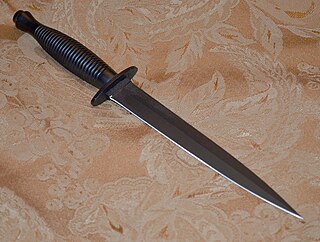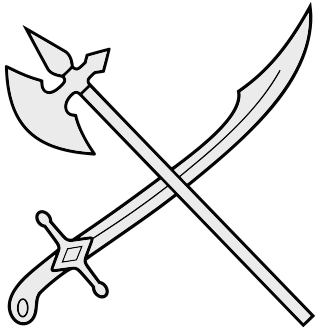
A dagger is a fighting knife with a very sharp point and usually one or two sharp edges, typically designed or capable of being used as a cutting or thrusting weapon. Daggers have been used throughout human history for close combat confrontations, and many cultures have used adorned daggers in ritual and ceremonial contexts. The distinctive shape and historic usage of the dagger have made it iconic and symbolic. A dagger in the modern sense is a weapon designed for close-proximity combat or self-defense; due to its use in historic weapon assemblages, it has associations with assassination and murders. Double-edged knives, however, play different sorts of roles in different social contexts.

Infantry is a specialization of military personnel who engage in ground combat on foot. Infantry generally consists of light infantry, irregular infantry, heavy infantry, mountain infantry, motorized infantry, mechanized infantry, airborne infantry, air assault infantry, and naval infantry. Other types of infantry, such as line infantry and mounted infantry, were once commonplace but fell out of favor in the 1800s with the invention of more accurate and powerful weapons.

A bayonet is a knife, dagger, sword, or spike-shaped weapon designed to fit on the end of the muzzle of a rifle, carbine, musket or similar firearm, allowing it to be used as a spear-like weapon. From the early 17th to the early 20th century, it was a melee weapon used by infantry for offensive and/or defensive tactics. Today, it is considered an ancillary weapon or weapon of last resort, although it is still used for ceremonial purposes.

A pike is a long thrusting spear formerly used in European warfare from the Late Middle Ages and most of the early modern period, and were wielded by foot soldiers deployed in pike square formation, until it was largely replaced by bayonet-equipped muskets. The pike was particularly well known as the primary weapon of Swiss mercenary, German Landsknecht units and French sans-culottes. A similar weapon, the sarissa, had been used in antiquity by Alexander the Great's Macedonian phalanx infantry.

A smatchet is a short, heavy fighting knife 16.5 inches (42 cm) in overall length. It was designed by William E. Fairbairn during World War II.
World War II combatives encompass a diverse range of combat techniques designed for close-quarters combat scenarios. These techniques include hand-to-hand fighting, advanced firearm point shooting methods, and skills with various weapons, such as knives, bayonets, and improvised implements. They were initially developed and taught to Allied special forces during World War II by prominent instructors, including Rex Applegate and William Ewart Fairbairn.

Close-quarters combat (CQC) or close-quarters battle (CQB) is a close combat situation between multiple combatants involving ranged or melee combat. It can occur between military units, law enforcement and criminal elements, and in other similar situations. CQB is typically defined as a short duration, high intensity conflict characterized by sudden violence at close range.
A stiletto is a specialized dagger with a long slender blade and needle-like point, primarily intended as a thrusting and stabbing weapon.

A ranged weapon is any weapon that can engage targets beyond hand-to-hand distance, i.e. at distances greater than the physical reach of the user holding the weapon itself. The act of using such a weapon is also known as shooting. It is sometimes also called projectile weapon or missile weapon because it typically works by launching solid projectiles ("missiles"), though technically a fluid-projector and a directed-energy weapon are also ranged weapons. In contrast, a weapon intended to be used in hand-to-hand combat is called a melee weapon.

A trench knife is a combat knife designed to kill or incapacitate an enemy at close quarters, such as in a trench or other confined area. It was developed as a close combat weapon for soldiers attacking enemy trenches during the First World War. An example of a World War I trench knife is the German Army's Nahkampfmesser.

Hand-to-hand combat is a physical confrontation between two or more persons at short range that does not involve the use of ranged weapons. The phrase "hand-to-hand" sometimes include use of melee weapons such as knives, swords, clubs, spears, axes, or improvised weapons such as entrenching tools. While the term "hand-to-hand combat" originally referred principally to engagements by combatants on the battlefield, it can also refer to any personal physical engagement by two or more people, including law enforcement officers, civilians, and criminals.

Insurgency weapons and tactics (IWAT) are weapons and tactics, most often involving firearms or explosive devices, intended for use by insurgents to engage in guerrilla warfare against an occupier, or for use by rebels against an established government. One type of insurgency weapon are "homemade" firearms made by non-professionals, such as the Błyskawica (Lightning) submachine gun produced in underground workshops by the Polish resistance movement. Another weapon that is part of the conventional military arsenal, but which has been taken up to great effect by insurgents, is the RPG. Two examples of an improvised weapon used by insurgents would be the improvised explosive devices used in Iraq and the Molotov cocktails used against vehicles and tanks. Two tactics used by many insurgents are assassinations and suicide bomb attacks. The latter tactic is used when an insurgent has a bomb strapped to them or in their car, which provides a low-tech way for insurgents to get explosives close to critical enemy targets.
A rifled musket, rifle musket, or rifle-musket is a type of firearm made in the mid-19th century. Originally the term referred only to muskets that had been produced as a smoothbore weapon and later had their barrels replaced with rifled barrels. The term later included rifles that directly replaced, and were of the same design overall as, a particular model of smoothbore musket.
A combat knife is a fighting knife designed for military use and primarily intended for hand-to-hand or close combat fighting.

An ancillary weapon is a weapon used to supplement a primary or main weapon in the event it cannot be used or is ineffective in a certain application or situation. Examples of ancillary weapons to main weapons include a melee weapon to a ranged weapon, a sidearm to a service weapon, or a light gun to a heavy cannon.

Combat is a purposeful violent conflict between multiple combatants with the intent to harm the opposition. Combat may be armed or unarmed. Combat is resorted to either as a method of self-defense or to impose one's will upon others. An instance of combat can be a standalone confrontation or part of a wider conflict, and its scale can range from a fight between individuals to a war between organized groups. Combat may also be benign and recreational, as in the cases of combat sports and mock combat.

The BC-41 was a combined knuckleduster and dagger weapon used by the British Commandos during World War II for close combat and ambushes. Although effective, it was eventually replaced by the Fairbairn–Sykes fighting knife.
The Battle of Danny Boy took place close to the city of Amarah in Southern Iraq on 14 May 2004, between British soldiers and about 100 Iraqi insurgents of the Mahdi Army. The battle is named after a local British checkpoint called Danny Boy.

A fighting knife has a blade designed to most effectively inflict injury in close-quarters physical confrontations. The combat knife and the trench knife are examples of military fighting knives.

An edged weapon, or bladed weapon, is a melee weapon with a cutting edge. Bladed weapons include swords, daggers, knives, and bayonets. Edged weapons are used to cut, hack, or slash; some edged weapons may also permit thrusting and stabbing. Edged weapons contrast with blunt weapons such as maces, and with thrusting weapons such as spears.















